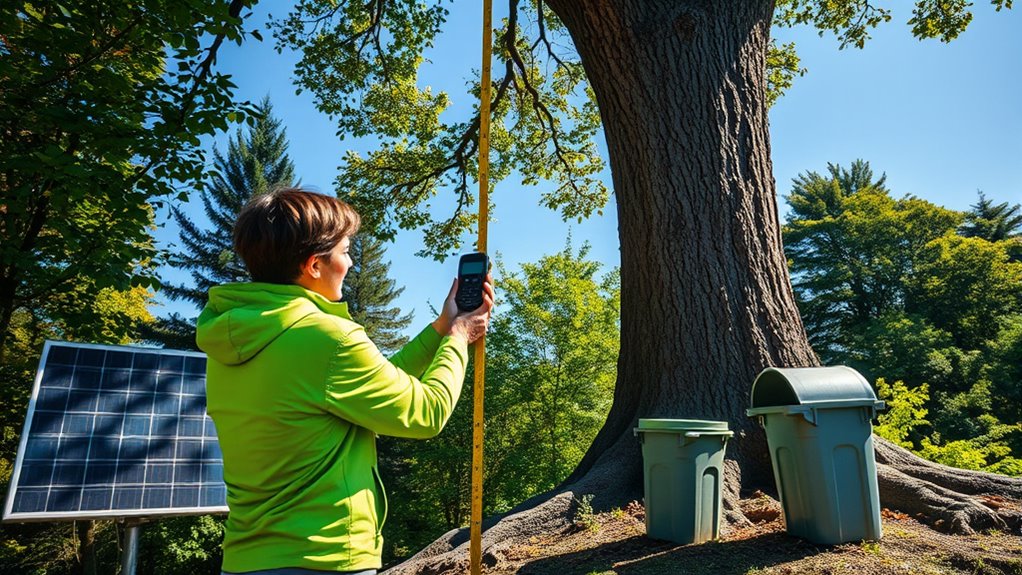To calculate your carbon footprint, assess your energy use, transportation, waste, and consumption habits using online tools or calculators, which help identify major emission sources like driving or home energy. To offset your emissions, support verified projects such as reforestation or renewable energy initiatives that effectively reduce greenhouse gases. Combining reduction efforts with offsets makes your impact more sustainable. Continue exploring ways to live more eco-friendly and maximize your positive influence on the environment.
Key Takeaways
- Use online calculators to assess emissions from energy use, transportation, waste, and consumption habits.
- Identify major emission sources in your lifestyle to target reduction efforts effectively.
- Choose renewable energy options like solar panels or green energy plans to lower household carbon footprint.
- Adopt sustainable transportation methods such as walking, biking, public transit, or electric vehicles.
- Support verified carbon offset projects like reforestation or renewable energy initiatives to compensate for unavoidable emissions.

Understanding your carbon footprint is the first step toward reducing your environmental impact. Once you recognize how your daily activities contribute to greenhouse gas emissions, you can start exploring ways to make meaningful changes. One effective approach is to shift toward renewable energy sources for your home and transportation needs. By choosing renewable energy options like solar, wind, or hydropower, you considerably decrease your reliance on fossil fuels, which are the primary culprits behind carbon emissions. Installing solar panels or opting for green energy plans from your utility provider can make a substantial difference. Additionally, embracing sustainable transportation methods is essential; this means walking, biking, or using public transit whenever possible. Not only do these choices cut down your carbon footprint, but they also promote healthier lifestyles and reduce traffic congestion. When you drive, consider switching to electric or hybrid vehicles that produce fewer emissions. Carpooling or shared rides can also be effective in decreasing the number of vehicles on the road, further lowering your overall impact. Being mindful of your transportation habits and making conscious choices about how you get around can lead to long-term benefits for the environment.
Calculating your carbon footprint involves evaluating the emissions generated by your household energy use, transportation, waste, and even consumption habits. Numerous online tools and calculators can guide you through this process, helping you identify the main sources of your emissions. Once you have a clear picture, you can target specific areas for improvement. For example, if transportation accounts for a large share of your emissions, focusing on sustainable transportation options will be more impactful. If your energy use is high, switching to renewable energy sources can considerably reduce your footprint.
Offsetting your carbon footprint involves compensating for your emissions by investing in projects that remove or reduce greenhouse gases elsewhere. This might include supporting reforestation efforts, renewable energy projects, or methane capture initiatives. When you offset your emissions, you’re effectively balancing out your environmental impact, making your overall footprint smaller. You can purchase carbon offsets through various organizations, ensuring your contributions go toward verified and impactful projects. Combining these actions—reducing your emissions through renewable energy and sustainable transportation, and offsetting what you can’t eliminate—creates a balanced approach to minimizing your environmental footprint. Over time, these practices become part of your lifestyle, helping you live more sustainably and encouraging others around you to do the same. Remember, every small step adds up, and your conscious actions can inspire wider change toward a healthier planet.
Frequently Asked Questions
How Accurate Are Carbon Footprint Calculators?
Carbon footprint calculators vary in measurement accuracy because of calculator limitations and data quality. You might find that they give a good estimate, but they can’t capture every detail of your lifestyle or emissions. Factors like regional differences and outdated data can affect results. So, while calculators are useful tools, remember they’re not perfectly precise and should be used as a starting point for understanding your impact.
What Are the Best Carbon Offset Projects?
You should look for carbon offset projects focusing on renewable energy and forest conservation, as they’re highly effective. Solar and wind energy projects replace fossil fuels, reducing emissions. Forest conservation efforts protect existing trees that absorb CO2. These projects are transparent, verifiable, and contribute to long-term climate benefits. By investing in them, you effectively offset your carbon footprint while supporting sustainable development and environmental preservation.
Can Individual Actions Significantly Reduce Overall Emissions?
Ever wondered if your personal behavior can truly make a difference? Yes, it can, especially when combined with supporting policy changes that promote sustainable practices. Your choices—like reducing energy use, choosing eco-friendly transportation, and advocating for greener policies—add up to significant emissions reductions. Don’t underestimate the power of individual actions; they can inspire larger systemic changes, ultimately helping to lower overall emissions and combat climate change effectively.
Are Carbon Offsets a Reliable Long-Term Solution?
Carbon offsets can be part of a reliable long-term solution if they support renewable energy and promote sustainable transportation. You should look for offsets that fund projects with proven environmental benefits, ensuring they truly reduce emissions. While offsets help, they shouldn’t replace direct actions like choosing renewable energy sources or adopting sustainable transportation habits. Combining offsets with personal efforts can lead to more meaningful, lasting impact on reducing your overall carbon footprint.
How Do I Verify the Credibility of Offset Providers?
You can verify the credibility of offset providers by checking for reputable offset certification logos, like Verra or Gold Standard, which ensure rigorous standards. Look for provider transparency in their projects—ask for detailed information on how offsets are generated and monitored. Do your research, read reviews, and confirm their claims align with industry standards. This way, you guarantee your offsets genuinely contribute to environmental goals.
Conclusion
By calculating and offsetting your carbon footprint, you’re not just making a small change—you’re literally saving the planet from turning into a giant, uninhabitable furnace! Every step you take, from reducing your emissions to investing in green projects, adds up to a superpower that can stop climate chaos in its tracks. So go ahead, be a hero in this epic battle against climate change—your actions could be the difference between a thriving Earth and a planet unrecognizable.








